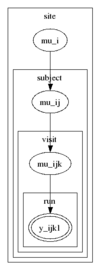Difference between revisions of "2008 Winter Project Week:fmri var"
m |
|||
| Line 29: | Line 29: | ||
<h1>Progress</h1> | <h1>Progress</h1> | ||
| + | |||
| + | We have built and tested a basic random effects model for data from each group and each load separately. The variance is largest for run which supports the hypothesis that using percent signal change minimizes overall site and subject variance. We formulated a new hierarchical model which encapsulates responses from both groups and all loads simultaneously, using a mixed effects setup. The advantage of of this new model is that it pools all of the data at once and can perform both the variance components analysis and the group difference estimation at the same time. The model is currently being tested. | ||
</div> | </div> | ||
Latest revision as of 14:48, 14 January 2008
Home < 2008 Winter Project Week:fmri var Return to 2008_Winter_Project_Week |
Key Investigators
- BWH: Kinh Tieu
Objective
The goal is to construct Bayesian hierarchical models of fMRI activation to account for variation due to run, visit, subject, and site.
Approach, Plan
We will test various models with differing hierarchical structure and conditional distributions and compare inferences on the same data under each model.
Progress
We have built and tested a basic random effects model for data from each group and each load separately. The variance is largest for run which supports the hypothesis that using percent signal change minimizes overall site and subject variance. We formulated a new hierarchical model which encapsulates responses from both groups and all loads simultaneously, using a mixed effects setup. The advantage of of this new model is that it pools all of the data at once and can perform both the variance components analysis and the group difference estimation at the same time. The model is currently being tested.
